Abstract
The effect of moisture content on structural properties such as apparent density, true density and porosity was investigated in this work for various vegetables after conventional drying. Samples of twelve different fresh vegetables (mushroom, green pepper, courgete, spinach, celery, leek, onion, tomato, garlic, carrot, pea, and corn) were dehydrated with conventional drying and the aforementioned properties were experimentally determined. A simple mathematical model was selected to correlate the obtained experimental data of true density, apparent density and porosity to material moisture content for each vegetable. The correlation results for the studied properties of the examined vegetables are presented in this article, along with the obtained model parameters.
INTRODUCTION
In recent years, much attention has been given to the quality of foods during drying. During water evaporation, changes on food physical structure take place and phenomena such as shrinkage determine the structural properties and the quality of the product. Generally, the product quality could be characterized by various properties such as color, texture, taste, density and porosity. Thus, it seems very important to study the effects of moisture content on the final products quality.[Citation1–6]
Air drying processes change the density of materials mainly due to the loss of moisture and formation of air pores. In this study, the effect of material moisture content on apparent density, true density, and porosity during conventional drying method has been investigated for twelve fresh vegetables. For this purpose, experimental data were obtained for all these vegetables through conventional drying and physical properties analysis. Typical conditions for the drying method were chosen. For the determination of moisture content, the samples were dried to constant weight at 70°C. The determination of true volume was carried out by using a helium stereopycnometer. For the determination of total volume, the volume displacement method was used. Both methods were carried out at 25°C. A literature review presented by Boukouvalas et al.[Citation7] showed the lack of complete series of experimental data (for both true and apparent density) for several of the studied vegetables (e.g., celery, corn, courgete, leek, pea, spinach, and tomato) and, thus, experiments for these vegetables were conducted.
Apart from the experimental determination of the examined properties, scope of this paper is also (a) to propose a mathematical model to calculate these properties as a function of the moisture content, and (b) to fit the proposed model to the obtained experimental data in order to obtain accurate estimations for the examined properties of the aforementioned vegetables.
MATERIALS AND EXPERIMENTAL PROCEDURE
Twelve different fresh vegetables were used as test materials. The vegetables used in this work were:
| • | Mushroom | ||||
| • | Green pepper | ||||
| • | Courgete | ||||
| • | Spinach | ||||
| • | Celery | ||||
| • | Leek | ||||
| • | Onion | ||||
| • | Tomato | ||||
| • | Garlic | ||||
| • | Carrot | ||||
| • | Pea | ||||
| • | Corn | ||||
Carrots were steam blanched for three minutes and then immersed in 2% sodium bisulfite solution for 5 min.[Citation8] Conventional drying was carried out in an air dryer at 70 ± 0.2°C and ∼7% air relative humidity, while the pressure was regulated at 1000 mbar ± 3%. Where applicable, samples were cut in cylinders of approximately 20-mm diameter and 10-mm height. In any other case, similar formation was chosen.
After dehydration, the samples were removed from the dryer at the required moisture content, and their weight, total volume, and true volume were measured. Three replicates for each sample were measured. Weight was measured by a Mettler AE-160 electronic balance with an accuracy of 10−4 gr. True volume was measured by a Quantacrome stereopycnometer (model SPV-3) with an accuracy of 0.001 ml. The total volume of the samples was measured by immersing them in n-heptane and determining the volume displacement, using the apparatus reported by Zogzas et al.[Citation9] with an accuracy of 0.05 ml. The volume measurements were carried out at 25°C. To determine the mass of dry solids, all samples were dried to constant weight in a vacuum oven at 5 mmHg and 70°C.[Citation8] In order to estimate a mean representative value for the dry solids density ρs, all dried samples of the same material were ground together and screened through a 65-mesh sieve, and the weight and true (particle) volume of dry solids were measured.
The obtained experimental data for all the vegetables examined in this work are presented in . In , experimental data obtained in this work are compared with available experimental data from literature. This was possible only for carrot (1a & 1b), garlic (1c & 1d), and onion (1e & 1f') due to the lack of complete series of experimental data. Although there are some differences, the obtained experimental sets from this work are generally in good agreement with all the other available sets. For carrot and onion, single values for apparent density are available by Rahman,[Citation16] and they are also in very good agreement with the corresponding ones obtained in this work. All experiments were conducted in the Laboratory of Process Analysis & Design in School of Chemical Engineering at National Technical University of Athens.
Table 1 The obtained experimental data points for true density, apparent density and porosity for various vegetables. Moisture values in bold denote the initial moisture content of each vegetable
Figure 1 (a) True density experimental data for carrot; (b) apparent density data for carrot; (c) true density experimental data for garlic; (d) apparent density data for garlic; (e) true density experimental data for onion; and (f) apparent density data for onion. Trendlines of all experimental data have been included in each figure.
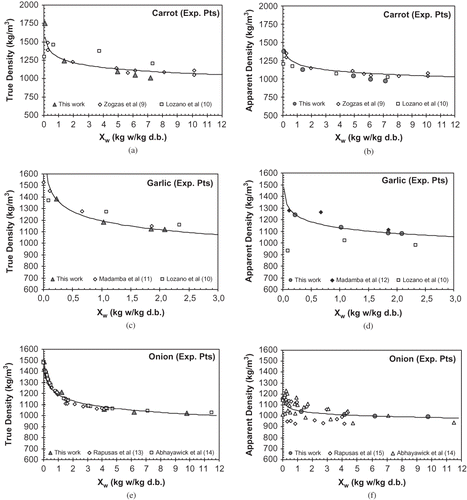
Figure 2 (a) True and apparent density of mushroom vs. moisture content; (b) porosity of mushroom vs. moisture content; (c) true and apparent density of green pepper vs. moisture content; (d) porosity of green pepper vs. moisture content; (e) true and apparent density of courgete vs. moisture content; and (f) porosity of courgete vs. moisture content. Experimental data obtained in this article ().
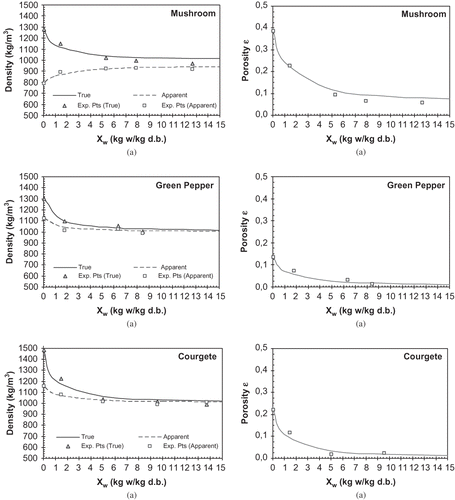
Figure 3 (a) True and apparent density of pea vs. moisture content; (b) porosity of pea vs. moisture content; (c) true and apparent density of celery vs. moisture content; (d) porosity of celery vs. moisture content; (e) true and apparent density of leek vs. moisture content; and (f) porosity of leek vs. moisture content. Experimental data obtained in this article ().
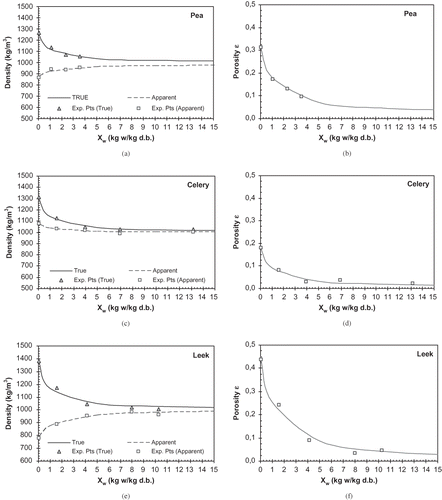
Figure 4 (a) True and apparent density of corn vs. moisture content; (b) porosity of corn vs. moisture content; (c) true and apparent density of tomato vs. moisture content; (d) porosity of tomato vs. moisture content; (e) True and apparent density of garlic vs. moisture content; and (f) porosity of garlic vs. moisture content. Experimental data obtained in this article ().
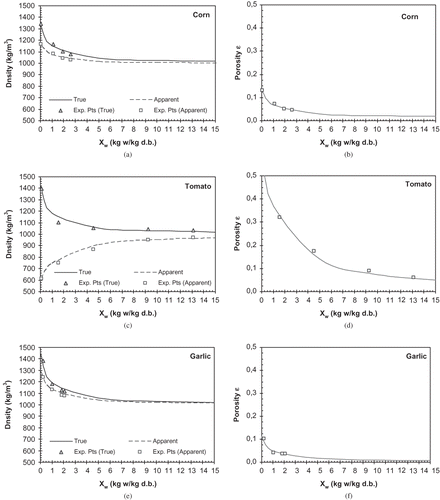
Figure 5 (a) True and apparent density of carrot vs. moisture content; (b) porosity of carrot vs. moisture content; (c) true and apparent density of spinach vs. moisture content; (d) porosity of spinach vs. moisture content; (e) true and apparent density of onion vs. moisture content; and (f) porosity of onion vs. moisture content. Experimental data obtained in this article ().
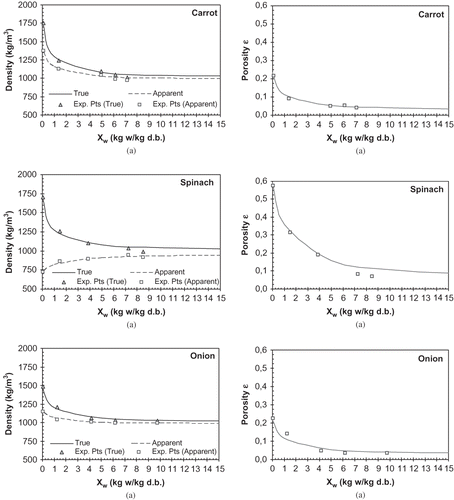
MATHEMATICAL MODEL
A simple mathematical model has been proposed in the literature to predict apparent density, true density, and porosity versus material moisture content.[Citation2,Citation5,Citation9]
True density (ρt) is the density of a pure substance or a material calculated from its components' densities considering conservation of mass and volume.[Citation16] It is determined by the mass of the sample and its true volume, excluding all pores. The term particle density is used for granular materials.
Apparent density (ρap) is the density of a substance including all pores remaining in the material.[Citation16] It is determined by the mass of the sample over the total volume of the sample. The term bulk density is used for granular materials
Porosity (ε) indicates the volume fraction of void space or air and is defined as the ratio of air or void volume divided by the total volume of the sample and it ranges between 0 and 1.[Citation16]
The proposed model is summarized in . This model involves four parameters with physical meaning: the density of enclosed water ρw, the dry solid density ρs, the dry solid apparent density ρa0 and the shrinkage coefficient β′. Equation (1) is used for the determination of true density (ρp) as a function of moisture content (X), considering that true density ranges between the dry solid density (ρs) and the density of the water (ρw). It corresponds to a two-phase serial mixing model. Similarly, in equation (2) apparent density ranges between the apparent density of dry solids (ρa0) and the enclosed water density (ρw). Again, Eq. (2) can be considered as a two-phase structural model. This definition involves three parameters: the apparent density of dry solids (ρa0), the enclosed water density (ρw), and the shrinkage coefficient β′. Finally, the total porosity is a function of apparent density and true density, Eq. (3).
Table 2 Mathematical model for calculating apparent density, true density and porosity as a function of moisture content
The parameter ρ s (which represents the material solid density) was calculated from the correlation of the obtained true density experimental data for each material and it was considered as a temperature-independent parameter, since no data, varying with temperature, were available. The water density (ρw) was considered constant (1000 kgr/m3) because the measurements were carried out at a constant temperature (25°C). Finally, the apparent density of dry solids (ρa0) and the shrinkage coefficient β′ were calculated from the correlation of the obtained apparent density experimental data for each material and they were considered as temperature-independent parameters. It must be noted that these four factors parameters are affected by the material, the drying method, and the drying conditions.
RESULTS AND DISCUSSION
The proposed mathematical model, presented in , was fitted to experimental data using a non-linear regression analysis method. Equation (1) was fitted to ρt experimental data and Eq. (2) to ρap experimental data. Furthermore, Eq. (3) was used to predict porosity values from experimental and calculates densities for comparison purposes. The results of parameter estimation are summarized in along with the corresponding values of % average absolute deviations (%AAD). The results from porosity comparisons are also presented in . The experimental data are presented in the corresponding figures. A comparison between the experimental (points) and the calculated values (lines) with the mathematical model is shown for apparent density, true density, and porosity in these figures.
Table 3 Results of the application of the mathematical model
True Density
True density increases as the water content decreases, which should be expected since it ranges between the density of water and the dry solids density.[Citation17] Thus, as the water is removed, the true density reaches the value of the dry solid density (ρs). The obtained solid density values for carrot, onion, and garlic are compared with the solid densities calculated by the proposed equations by Boukouvalas et al.,[Citation18] and they are in very good agreement. The corresponding deviations between the calculated values in this work and those in Boukouvalas et al.[Citation18] are 13.9, 1.4, and 3.1%, respectively.
Apparent Density
Considering Eq. (2), apparent density ranges between the density of water and the density of the completely dry material (ρa0). As a result, the value of bulk density at high moisture content, approximates the density of water, while at low moisture content values, it tends to the value of ρa0. The measured apparent density values for carrot, celery, garlic, mushroom, onion, pea, and tomato have been compared with experimental values presented in literature[Citation18] and they are in reasonably good agreement. The obtained values of volume-shrinkage coefficients (β') for the studied vegetables are very close to unity. This is expected since conventional drying does not affect this parameter.[Citation2]
Porosity
The prediction of the porosity with the proposed model was in good agreement with the experimental data. Since the porosity depends on the apparent as well as true densities, the magnitude of variation in porosity depends on these factors only. The porosity of the studied materials increases with the removal of moisture content as it is expected. The obtained values were no greater than 0.50 in most cases since the samples have been dried with conventional air-drying method.
CONCLUSIONS
Experimental values for true density, apparent density, and porosity vs. moisture content were obtained for twelve fresh vegetables. A simple mathematical model was selected to correlate these experimental data for each examined vegetable. The description of the experimental data with the aforementioned model was very satisfactory taking into account the simplicity of the selected model.
REFERENCES
- Saravacos , G.D. 1967 . Effect of the Drying Method on the Water Sorption of Dehydrated Apple and Potato . Journal of Food Science , 3 : 81 – 84 .
- Krokida , M.K. and Maroulis , Z.B. 1997 . Effect of Drying Method on Shrinkage and Porosity . Drying Technology , 15 ( 10 ) : 2441 – 2458 .
- Krokida , M.K. , Karathanos , V.T. and Maroulis , Z.B. 1998 . Effect of Freeze-drying Conditions on Shrinkage and Porosity of Dehydrated Agricultural Products . Journal of Food Engineering , 35 : 369 – 380 .
- Krokida , M.K. and Maroulis , Z.B. 2000 . “ Quality change during drying of food materials ” . In Drying Technology in Agriculture and Food Sciences , Edited by: Mujumdar , A.S. 61 – 106 . Enfield, NH : Science Publishers, Inc .
- Saravacos , G.D. and Maroulis , Z.B. 2001 . Transport Properties of Foods , 36 – 62 . New York : Marcel-Dekker .
- Maroulis , Z.B. and Saravacos , G.D. 2003 . Food Process Design , New York : Marcel-Dekker .
- Boukouvalas , CJ , Krokida , MK , Maroulis , ZB and Marinos-Kouris , D. 2006 . Densities and porosity: Literature data compilation for foodstuffs . International Journal of Food Properties , 9 ( 4 ) : 715 – 746 .
- Van Arsdel , W.B. and Copley , M.J. 1964 . Food Dehydration , Vol. 2 , Westport, CT : AVI Publishing .
- Zogzas , N.P. , Maroulis , Z.B. and Marinos-Kouris , D. 1994 . Densities, Shrinkage and Porosity of Some Vegetables During Air Drying . Drying Technology , 12 ( 7 ) : 1653 – 1666 .
- Lozano , J.E. , Rotstein , E. and Urbicain , M.J. 1983 . Shrinkage, Porosity and Bulk Density of Foodstuffs at Changing Moisture Contents . Journal of Food Science , 48 : 1497 – 1553 .
- Madamba , P.S. , Driscoll , R.H. and Buckle , K.A. 1994 . Shrinkage, Density and Porosity of Garlic During Drying . Journal of Food Engineering , 23 : 309 – 319 .
- Madamba , P.S. , Driscoll , R.H. and Buckle , K.A. 1994 . Bulk Density, Porosity and Resistance to Airflow of Garlic Slices . Drying Technology , 12 ( 4 ) : 937 – 954 .
- Rapusas , R.S. and Driscoll , R.H. 1995 . Thermophysical Properties of Fresh and Dried White Onion Slices . Journal of Food Engineering , 24 : 149 – 164 .
- Abhayawick , L. , Laguerre , J.C. , Tauzin , V. and Duquenoy , A. 2002 . Physical Properties of Three Onion Varieties as Affected by the Moisture Content . Journal of Food Engineering , 55 : 253 – 262 .
- Rapusas , R.S. , Driscoll , R.H. and Srzednicki , G.S. 1995 . Bulk Density and Resistance to Airflow of Sliced Onions . Journal of Food Engineering , 26 : 67 – 80 .
- Rahman , M.S. 1995 . Food Properties Handbook , 196 – 209 . New York : CRC Press .
- Krokida , M.K. , Kiranoudis , C.T. , Maroulis , Z.B. and Marinos-Kouris , D. 2000 . Drying Related Properties of Apple . Drying Technology , 18 ( 6 ) : 1251 – 1267 .
- Boukouvalas , CJ , Krokida , MK , Maroulis , ZB and Marinos-Kouris , D. 2006 . Effect of material moisture content and temperature on the true density of foods . Int. J. Food Prop. , 9 ( 1 ) : 109 – 125 .